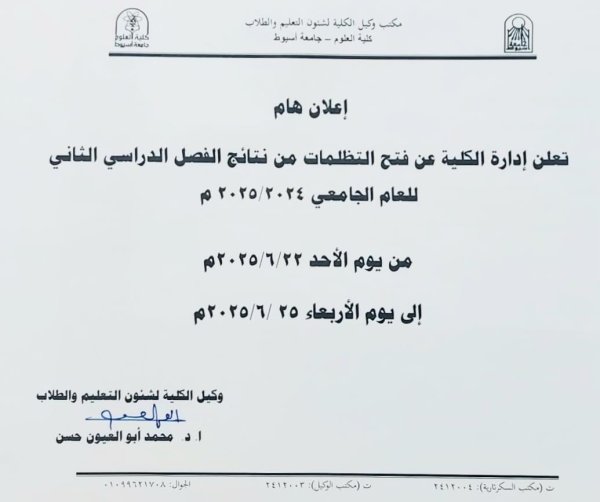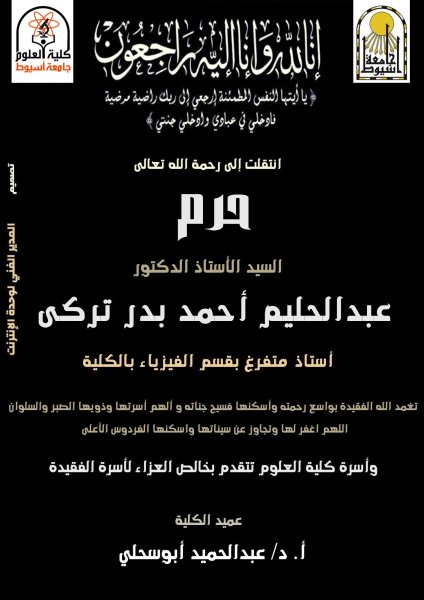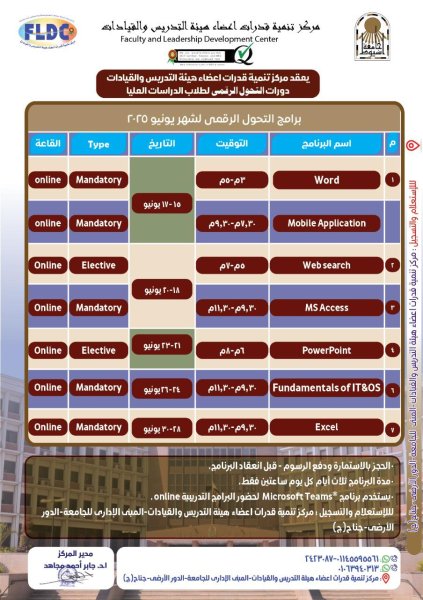
Announcement for student
Announcement


أبناؤنا الطلاب والخريجين… انتظرونا
قريبًا… فتح باب التسجيل في مبادرة "كن مستعدًا"، إحدى آليات تنفيذ المبادرة الرئاسية "تحالف وتنمية"، والتي تنفذها وزارة التعليم العالي والبحث العلمي، بالشراكة مع صندوق تطوير التعليم وكبرى المؤسسات الدولية.
تُنفذ المبادرة بجميع مراكز التوظيف والتطوير المهني بالجامعات المصرية.
استعدوا للانطلاق… كن مستعدًا
Digital transformation exams's Table
Information network" Assiut University announces the dates of digital transformation exams for graduate students
New tetrahydroisoquinoline-4-carbonitrile derivatives as potent agents against cyclin-dependent kinases, crystal structures, and computational studies
Investigation of synthesis, spectroscopic characterization, crystal structure, and computational studies of 3-(4-(dimethylamino)phenyl)-1,5-di(thiophen-2- yl)pentane-1,5-dione as potent against Cathepsin S
Nanoscale dynamics of Dynamin 1 helices reveals squeeze-twist deformation mode critical for membrane fission
Rational Design of a Copper(I) Complex Derived from an Asymmetric Thiourea Ligand with High Antifungal Activities
The reaction of 1-(2,5-dimethylphenyl)-3-phenylthiourea (L) and copper(II) chloride dihydrate resulted in production of the complex [CuL2Cl] which contains monovalent copper. The complex was isolated in the monoclinic crystal system (space group = C 1 2/c 1) and its coordination geometry is trigonal planar composed of one chlorine and two sulfur atoms. The complex (150 µg/mL) provided significant inhibitory activity (40.5 mm) against the phytopathogen Fusarium oxysporum and led to complete inhibition of F. oxysporum-induced pathogenicity to wheat seeds. Percentages of wheat germination, evidence of phytotoxicity levels, were investigated: [CuL2Cl] (150 µg/mL) offered percent germination of 67%, but the ligand was less toxic offering percentage of germination of 77%. Reduction in shoot lengths (control = 41 mm) and root lengths (control = 54.3 mm) of germinated wheat seeds influenced by our compounds was cleared. At 150 µg/mL, 1-(2,5-dimethylphenyl)-3-phenylthiourea, copper(II) chloride dehydrate, and [CuL2Cl] offered shoot lengths of 26.3, 9.6, and 29.3 mm and root lengths of 34.7, 0, and 26.6 mm, respectively.
Insights into structural and spectral properties of cobalt (II) complexes bearing asymmetric thiourea ligands and their remarkable bioactivities against Gram negative bacteria
A major number of sulfur compounds including derivatives of thiourea is medicinally important agents and metal
complexes of thioureas are often more medicinally active. Monoisopropylamine and m-toluidine, as aliphatic and
aromatic amines, were used to prepare monodentate thiourea ligands [1-isopropyl-3-phenylthiourea (L1) and 1-
phenyl-3-m-tolylthiourea (L2), respectively] and single crystals of cobalt complexes incorporating these ligands
were also isolated. These tetrahedral complexes, [Co(L1)2Cl2] and [Co(L2)2Cl2], were demonstrated in different
lattice packings (orthorhombic and monoclinic, respectively). To characterize the antibacterial patterns (percent
growth inhibitions and percent viability inhibitions) of these compounds, the activities of dimethyl sulfoxide
solutions (50–200 μg/ml) of them against Gram negative bacterial strains (i.e., Klebsiella pneumoniae, Pseudo-
monas aeruginosa and Serratia marcescens) were determined. Chloramphenicol (CHL) was used as the commercial
standard. At 200 μg/ml, the complex Co-L1 inhibited these bacteria by 94.9, 92.2 and 69.8 % and Co-L2 inhibited
them by 86.0, 87.0 and 78.3 % (92.1, 86.6 and 72.3 % by CHL), respectively. Furthermore, [Co(L1)2Cl2] and [Co
(L2)2Cl2] offered bactericidal action with 100 % viability inhibition against Klebsiella pneumoniae, but the action
was bacteriostatic with 72.3–96.2 % and 84.4–96.9 % viability inhibitions against Pseudomonas aeruginosa and
Serratia marcescens, respectively.








